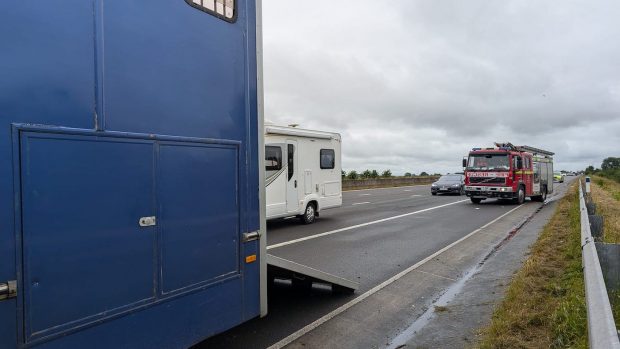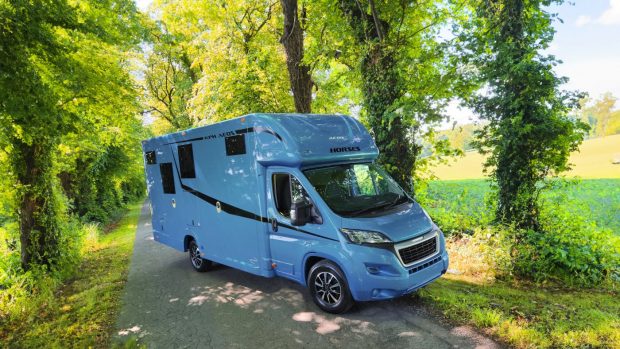Racing is now a truly international sport with horses flying all over the world to compete on different continents for big prizes. Travelling head girl to trainer Andrew Balding Leanne Masterton explains what’s involved when flying overseas with a horse. Together with seven-year-old gelding, Side Glance (pictured below), the pair have travelled the world to compete in destinations as varied as Australia, Dubai, Hong Kong, Singapore and America.
Preparation is key
A great deal of preparation goes into ensuring racehorses receive the highest standard of care throughout their trips abroad. There are a wide range of factors to take into account, including how training schedules fit in with lengthy flights, ensuring racehorses are fed and watered during the journey, dealing with quarantine regulations in different countries, and ensuring that all the necessary paper work is in order ahead of travelling. Racing overseas is planned months in advance to ensure that everything runs smoothly and the horse’s journey is as comfortable as possible.
Tack is the last thing to be packed
As travelling head girl, it is Leanne’s job to prepare for the trip: “I will usually get all the gear ready the week before we fly, as between going racing and riding out it’s nearly always a manic week. Tack is the last thing I pack because if it’s a late afternoon or evening flight I will have to ride out first. However, the horse that is flying will get the morning off. Once the hampers are packed and ready, it’s just water containers to be filled, haynets to be stuffed and enough feed readied for the journey.”
Quarantine
Australia is the only country that Leanne has travelled to where horses have to spend two weeks in quarantine in the UK before they leave. This is because, with no equine influenza in Australia, they do not currently vaccinate against it as they do in every other racing country. Racehorse quarantine in the UK is done at Side Hill Stud in Newmarket.
“We shower every time we enter quarantine and horses are allowed to use designated gallops only between 4pm and 5pm as quarantine regulations do not permit them to be within 100 meters of a horse that is not in quarantine.
“Every piece of exercise is supervised by a vet and a team of staff, who also keep dog walkers away. During this period blood and nasal swab tests are done for equine influenza, among other equine diseases. Horses temperatures are also taken twice daily. After two weeks, providing all the tests are clear, it’s time to fly.”
When travelling anywhere else in the world with horses, the same tests have to be done and have to be clear prior to flying. The tests can be carried out at home and the horse will not enter quarantine until it arrives abroad. The racehorses stay in quarantine overseas for the duration of their stay, and in America, horses are kept in isolation for at least 72 hours.
Take-off
With equine air travel increasing, racehorses will usually be flown in custom-built aircraft adapted specifically for transporting horses. “Pilots will not allow people to stay in the hold with the horses during take off. Racehorses are used to travelling in a horsebox and generally they are not fussed by getting on a plane. I have never been on a flight where a horse has got upset.
“After take off I will untie him [Side Glance], as he likes to stand backwards and sleeps a fair bit. I can’t say who sleeps more, him or me. On a flight full of horses, there are no air stewards or stewardesses, so the grooms and vets are left to fend for themselves. No in flight entertainment either, so a good book is essential!”
Keeping hydrated
While flying, it is very important to keep horses hydrated. “Before we leave, any horse of Andrew’s that is flying will be given a Duphalyte IV drip by the vet, this is full of vitamins and minerals. During the flight I would offer water every couple of hours. If a horse isn’t drinking well after a couple of hours I would give them some electrolyte paste by mouth, it’s full of salts and minerals and encourages them to drink.
“A vet will always be on board along with an assistant, so should a horse show signs of becoming dehydrated they will administer IV fluids. But I have never been on a flight where this has had to be done.”
Careful feeding
“Feeding on a flight has to be done with care, greedy horses eating too much can develop colic so I have found it best to feed little every four to six hours and, if possible, off the floor of the stall. This encourages horses to get their heads down, so there is more chance of anything in their lungs from the air con running out.”
Landing
On landing, the horses are transported straight to quarantine when in Australia or the stables reserved for international runners in other countries.
“Once the horses have had a good walk they are put into their new stables and temperatures are taken. A risen temperature is the first indication of a horse developing travel sickness so temperatures are taken twice a day for two weeks again. This is witnessed by a vet every morning and closely monitored. I’m lucky in that no horse I have ever travelled has suffered from travel sickness but I have seen it in Hong Kong and Australia. Horses develop a high temperature, a cough, a dirty nose and look dull in their coat. They have to be treated with antibiotics and it takes time for them to recover.”
Exercising after a flight
“After 36 hours travelling, you don’t put a horse under any strain in their exercise. So, following our arrival Down Under, it is a couple of days just leading out and picking grass, giving them time to acclimatise. This time in Australia [where Side Glance ran in the Cox Plate], we also have Van Percy who was second in the Ebor. Although he was a first time flyer Van Percy only lost 3kg on the flight, and Side Glance, the old pro, lost 14kg! This is normal for him, and it only takes two days for him to it put back on.
“Both horses were being prepared to run exactly two weeks after landing so after a couple of days walking in the compound we hit the track for a trot. Both horses pulled our arms out trotting, Matti, who rides Van Percy, and I were still suffering with jet lag and it’s fair to say the horses recover a lot quicker than us!”
Trainers will aim to have a horse primed and race fit before they travel so they will only need easy work after landing in the immediate build up to a race.
“After a few days of steady cantering Side Glance did his first easy piece of work on the Tuesday before the race. He did his alone as he can pull very hard in company and we didn’t want him to do too much. The days leading up to the race they are just kept ticking over with steady canters. On the day before, I allow ‘Sidey’ an inch or two of rein so he can stretch out down the straight as he has been known to run gassy and keen if too fresh.”
Coming home
“When Side Glance arrives home from a trip the first thing he does is roll in his own stable, he will then check out his feed pot before he has a long sleep.
“The day after a trip abroad he goes for a mini break to Chris Bonner’s (Andrew Balding’s assistant). He always has the same stable there and will jump off the lorry ramp when he arrives. He gets to play in the paddock but he also has an hour a day on the horse walker, otherwise he lets himself go a little too much. He was there for 10 days after travelling to Chicago this year and put on 25kg… He loves it there!!”
Meet Paul Nicholls’ stable stars [VIDEO]
As the 2014-15 National Hunt season gathers pace, H&H visits eight-times champion trainer Paul Nicholls at his yard in Somerset

A day in the life of champion trainer Paul Nicholls *PICTURES*
With around 120 horses in residence at Manor Farm Stables in Somerset, it’s a 24-7 job for Champion National Hunt





